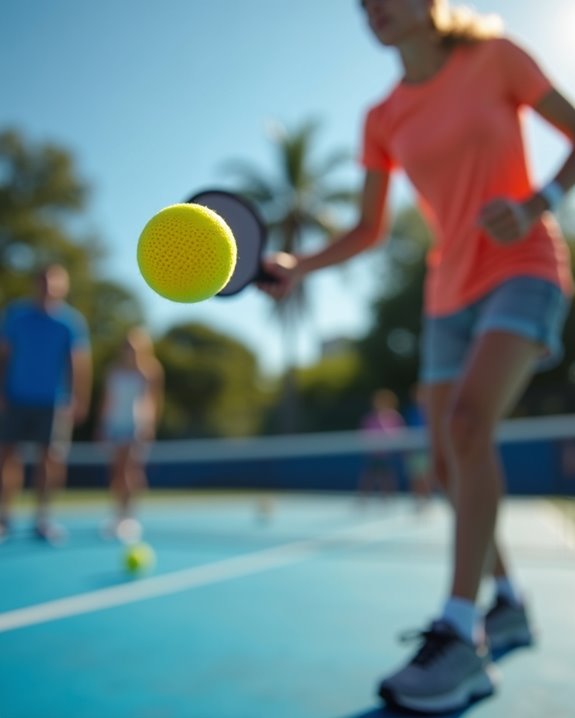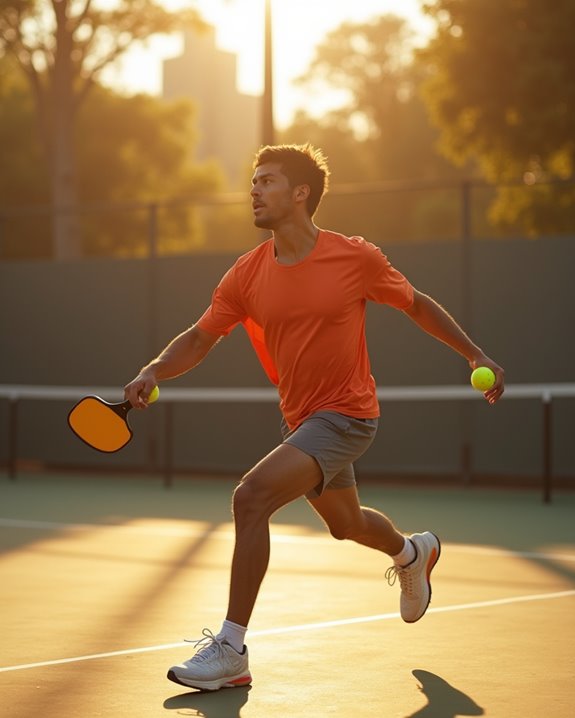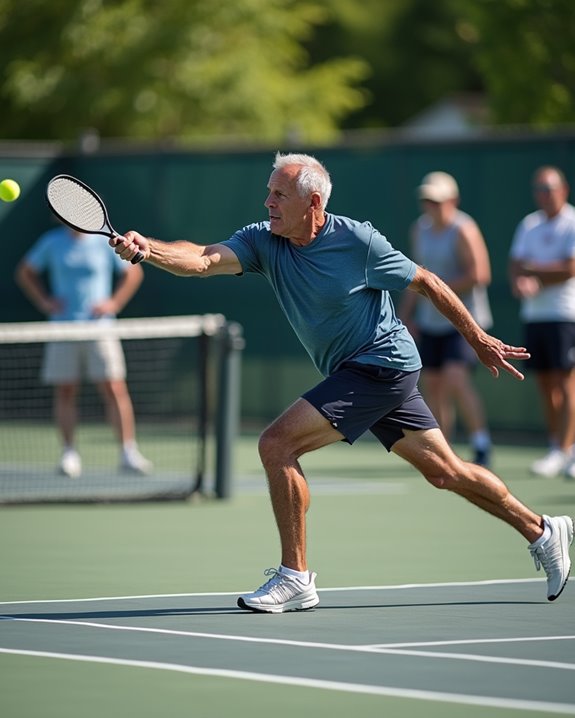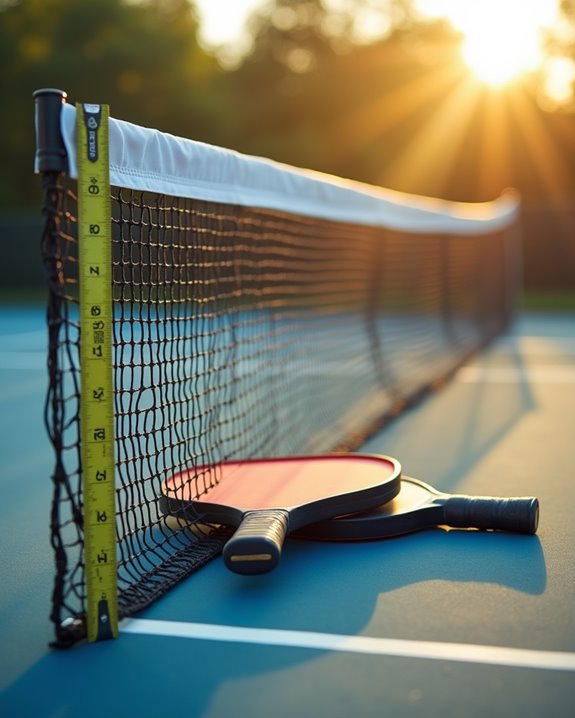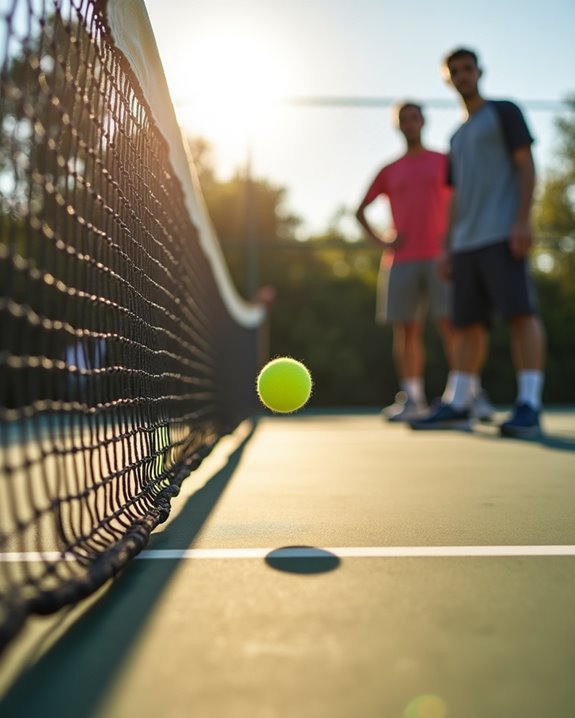In pickleball, volleys are shots hit before the ball bounces, serving as essential ingredients in your strategic recipe. You’ll need to master both forehand and backhand techniques while remembering to stay out of the “kitchen” (non-volley zone). For best results, maintain a continental grip, use short controlled strokes, and position yourself with bent knees in a ready stance. Proper footwork and anticipation are the secret sauce that will elevate your volley game from amateur to chef-level player.
Key Takeaways
- Volleys are shots hit in the air before the ball bounces, requiring a short controlled swing with proper paddle grip.
- Stay out of the kitchen (non-volley zone) when hitting volleys to avoid faults.
- Position yourself in a ready stance with knees bent and aim to direct volleys downward into your opponent’s court.
- Practice both forehand volleys (dominant side) and backhand volleys (cross-body) for complete court coverage.
- Focus on proper footwork, anticipation, and maintaining balance to execute effective volleys during gameplay.
What Is a Volley in Pickleball?
When you’re stepping onto the pickleball court with aspirations to elevate your game, understanding the volley is absolutely vital to your recipe for success. A volley occurs when you strike the ball out of the air before it bounces—like snatching a fresh ingredient mid-air!
You’ll execute volleys in two main flavors: forehand and backhand. The forehand volley uses your dominant side, while the backhand requires a cross-body motion. These quick-fire shots add spice to your gameplay by increasing the tempo and putting pressure on opponents.
Remember the essential rule: you must stay out of the non-volley zone (the “kitchen”) when performing volleys. Stepping into this restricted area while volleying results in a fault—just like using salt when the recipe calls for sugar!
The Role of Volleys in Game Strategy
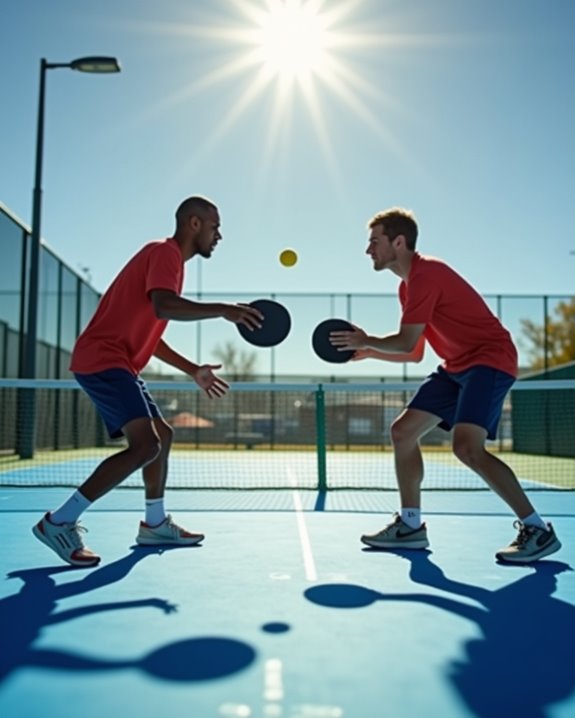
As you develop your pickleball skills, volleys become the secret sauce that transforms your game from bland to grand! By mastering volleys, you’re fundamentally controlling the net—the prime real estate of the pickleball court.
Think of your volleys as the main ingredient in your strategic recipe. When you volley effectively, you’re simmering pressure on your opponents by reducing their reaction time. You’ll force them into a defensive stew, creating delicious opportunities for quick points.
Your game strategy should fold in both forehand and backhand volleys to respond to shots coming from any direction. Precise, low volleys disrupt your opponent’s rhythm—like adding a surprise spice that throws off their entire dish. By incorporating this technique, you’ll shift momentum and serve up a more aggressive, dominant style of play!
Mastering the Forehand Volley Technique
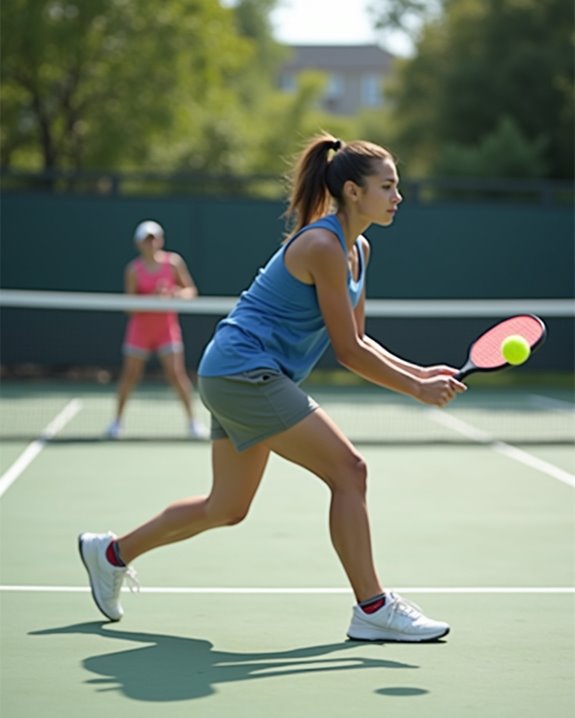
Mastering the Forehand Volley Technique
The forehand volley serves as the bread and butter of your pickleball arsenal! Like folding ingredients into a perfect batter, you’ll want to blend proper form with precise timing.
Start by holding the paddle with a continental grip at 10-11 o’clock—this creates the perfect “pan” to serve up a crisp shot. Position yourself in a ready stance, feet shoulder-width apart, knees slightly bent like a chef poised to flip a delicate soufflé.
When it’s time to contact the ball, keep your swing short and controlled, like gently folding egg whites. Meet the ball in front and above your body, directing it downward into your opponent’s court. Remember, this isn’t about power—it’s about precision, like drizzling the perfect amount of sauce on a gourmet dish. Additionally, using a paddle with vibration dampening effectiveness can help minimize any discomfort in your arm while executing your shots.
Developing a Strong Backhand Volley

Many pickleball enthusiasts find the backhand volley as challenging as perfecting a delicate soufflé—it requires patience, technique, and practice!
Start by adopting a continental grip—think of holding a frying pan handle firmly but not too tight. Position yourself sideways to the net with your non-dominant foot forward, like you’re preparing to fold ingredients into your mixture. Your paddle face should be slightly angled downward, similar to tilting a spatula to gently fold egg whites.
To simmer down your backhand volley skills, keep your stroke short and concise—no wild stirring motions! Proper shoulder rotation is your secret ingredient here. Practice regularly with wall volleys and partner exchanges to build muscle memory.
Understanding the Non-Volley Zone Rules
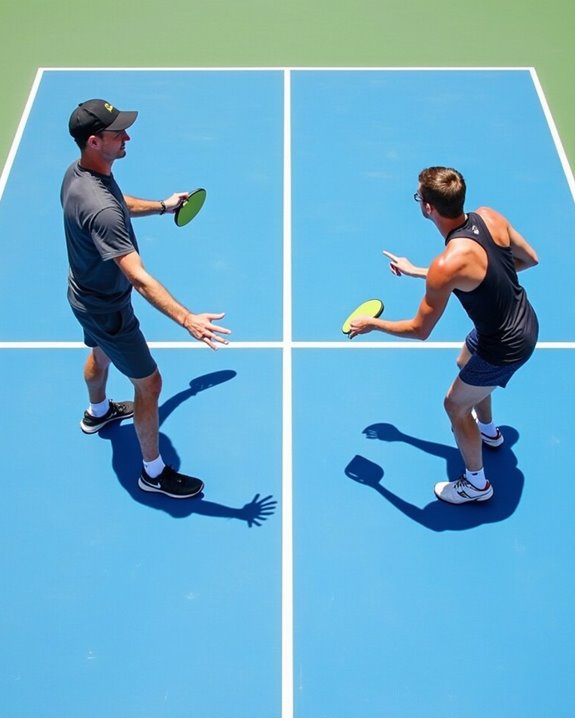
While mastering volleys might seem like the main course of your pickleball journey, maneuvering the non-volley zone (NVZ) rules is the essential seasoning that’ll make or break your game!
The kitchen—as players affectionately call the NVZ—extends 7 feet from each side of the net. You cannot hit a volley while standing in this zone. Think of it as a hot stovetop you shouldn’t touch! When making contact with the ball, your feet must be completely outside this area.
If you step into the kitchen during or immediately after a volley, you’ve committed a fault—like burning your signature dish! This rule prevents players from dominating the net and encourages strategic rallies instead. Master this recipe for success, and you’ll avoid serving up unnecessary points to your opponents.
Proper Positioning and Footwork for Effective Volleys
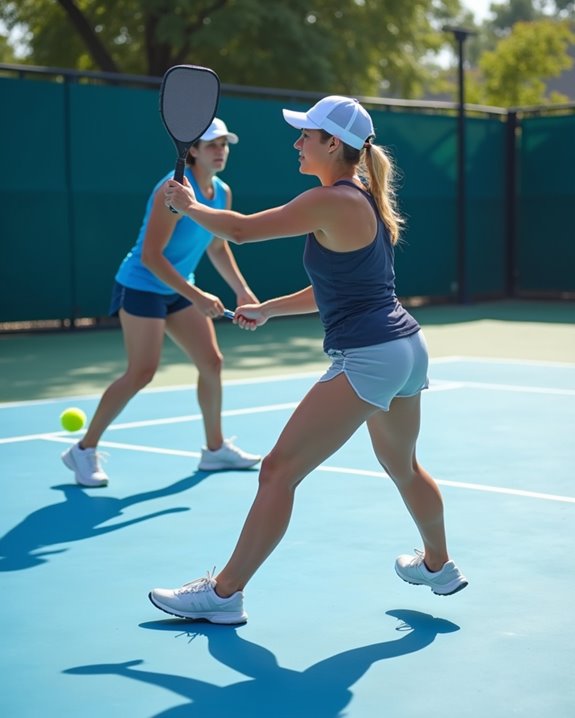
Standing correctly at the kitchen’s edge can transform your volleys from bland to gourmet! Your proper positioning starts with a balanced athletic stance—feet shoulder-width apart, knees slightly bent like you’re folding a delicate batter. Stay close to the non-volley line to serve up quick reactions!
Your footwork is the secret sauce of successful volleys. Use small, shuffling steps to adjust your position rather than lunging wildly. Think of it as stirring a pot—controlled movements yield the best results.
Maintain a ready position with arms slightly bent and paddle up, as if you’re preparing to fold ingredients into your next shot. This preparation lets you respond instantly whether the ball comes to your forehand or backhand side. Stay nimble and poised!
Common Volley Mistakes and How to Avoid Them
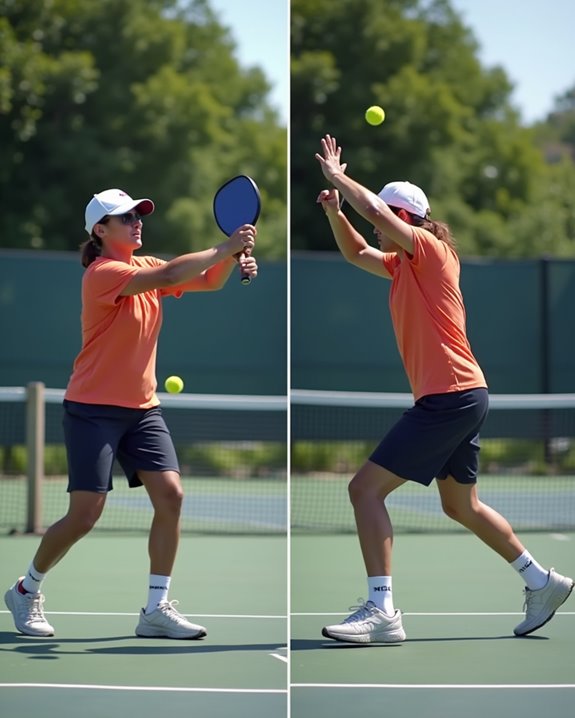
Now that you’ve mastered your positioning, let’s examine the recipe for volley disaster! Over-hitting volleys is like adding too much spice—it overwhelms your game and sends balls flying out of bounds. Instead, fold in control with your power for a perfectly balanced shot.
Neglecting proper footwork is another common ingredient for failure. Keep your feet shoulder-width apart and stay light like a soufflé on your toes. This creates the perfect base for reaching those difficult shots.
Don’t let your mental concentration simmer down during rallies! Stay engaged with your opponent’s movements and visualize successful volleys. Think of your focus as the binding agent that keeps your volley game together. Remember, anticipation is the secret sauce to effective volleying! Additionally, using a grip designed for sweat absorption capacity can help maintain control during intense rallies.
Essential Drills to Improve Your Volley Skills
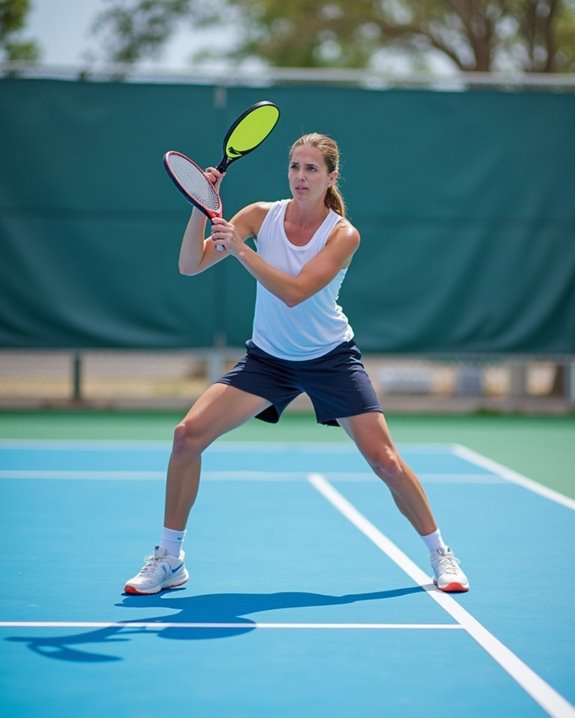
Ready to spice up your pickleball practice? These essential drills will transform your volley skills from raw to perfectly seasoned! Start with the Wall Volley Drill—a classic recipe for building consistency as you bounce shots back and forth against a solid surface.
Next, fold in some Partner Volley practice, where you’ll exchange shots like passing ingredients across a kitchen counter. To add precision to your game, sprinkle in some Target Practice by aiming at specific spots on the court.
For those looking to improve your skills under pressure, the Reaction Volley Drill serves up rapid-fire exchanges that sharpen reflexes. Finally, simmer in the Kitchen Awareness Drill, positioning yourself properly outside the non-volley zone for defensive success.
Advanced Volley Strategies for Competitive Play
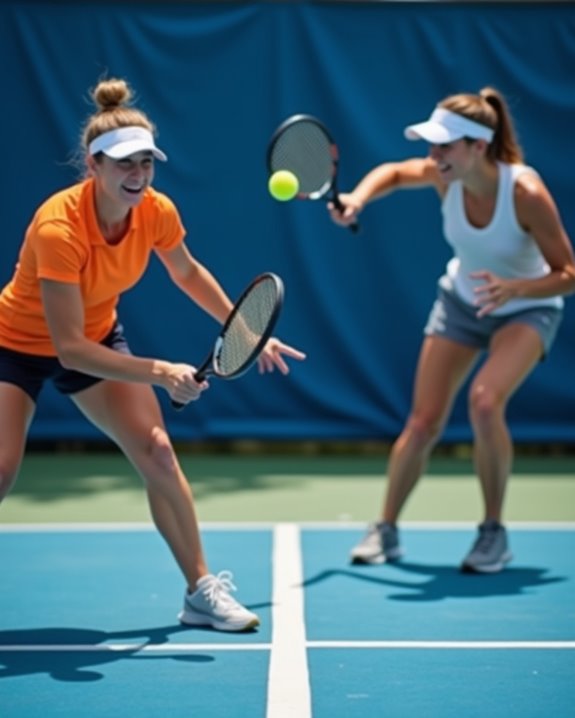
While mastering basic volleys will get you started, competitive pickleball requires you to add more sophisticated flavors to your game. Think of your volleys as a chef’s specialty dishes—some need to be served with gentle precision, others with powerful flair.
When hitting a volley, mix up your recipe by incorporating both soft and angled shots that force opponents to scramble across the court. These strategic placements can simmer pressure on your opposition, causing them to serve up errors. Various types of volleys in your arsenal—like the punch volley or drop volley—create an unpredictable menu for opponents to digest.
Your mental preparation is the secret sauce! Visualize successful exchanges before they happen, and maintain a firm paddle grip while keeping your footwork fluid—essential ingredients for competitive success.
Frequently Asked Questions
How to Volley in Pickleball for Beginners?
Keep your eye on the ball! Master volley technique tips by maintaining a ready stance, using continental grip, and contacting the ball high. Practice footwork fundamentals and avoid common mistakes like dropping your paddle between shots.
What Is the Best Grip for Volleys in Pickleball?
The continental grip is best for volleys. You’ll want to position your hand with this grip type, holding the paddle at a 10-11 o’clock angle. It allows quick shifts between forehand and backhand shots.
What Is the Golden Rule Pickleball?
In pickleball, the Golden Rule (Two-Bounce Rule) requires the ball to bounce once on each side before volleys begin. Good pickleball etiquette means respecting this while maintaining proper volley positioning. Common mistakes include volleying too early.
How to Get More Power on Pickleball Volleys?
To get more power on volleys, you’ll need proper body positioning with bent knees and engaged core. Try volley drills focusing on shoulder rotation and forward momentum. These power techniques create stronger shots without wrist flicking.

